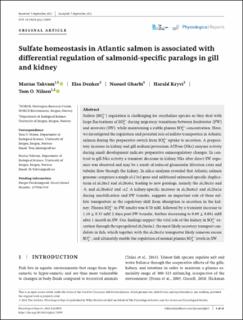| dc.description.abstract | Sulfate (urn:x-wiley:2051817X:media:phy215059:phy215059-math-0001) regulation is challenging for euryhaline species as they deal with large fluctuations of urn:x-wiley:2051817X:media:phy215059:phy215059-math-0002 during migratory transitions between freshwater (FW) and seawater (SW), while maintaining a stable plasma urn:x-wiley:2051817X:media:phy215059:phy215059-math-0003 concentration. Here, we investigated the regulation and potential role of sulfate transporters in Atlantic salmon during the preparative switch from urn:x-wiley:2051817X:media:phy215059:phy215059-math-0004 uptake to secretion. A preparatory increase in kidney and gill sodium/potassium ATPase (Nka) enzyme activity during smolt development indicate preparative osmoregulatory changes. In contrast to gill Nka activity a transient decrease in kidney Nka after direct SW exposure was observed and may be a result of reduced glomerular filtration rates and tubular flow through the kidney. In silico analyses revealed that Atlantic salmon genome comprises a single slc13a1 gene and additional salmonid-specific duplications of slc26a1 and slc26a6a, leading to new paralogs, namely the slc26a1a and -b, and slc26a6a1 and -a2. A kidney-specific increase in slc26a6a1 and slc26a1a during smoltification and SW transfer, suggests an important role of these sulfate transporters in the regulatory shift from absorption to secretion in the kidney. Plasma urn:x-wiley:2051817X:media:phy215059:phy215059-math-0005 in FW smolts was 0.70 mM, followed by a transient increase to 1.14 ± 0.33 mM 2 days post-SW transfer, further decreasing to 0.69 ± 0.041 mM after 1 month in SW. Our findings support the vital role of the kidney in urn:x-wiley:2051817X:media:phy215059:phy215059-math-0006 excretion through the upregulated slc26a6a1, the most likely secretory transport candidate in fish, which together with the slc26a1a transporter likely removes excess urn:x-wiley:2051817X:media:phy215059:phy215059-math-0007, and ultimately enable the regulation of normal plasma urn:x-wiley:2051817X:media:phy215059:phy215059-math-0008 levels in SW. | |

